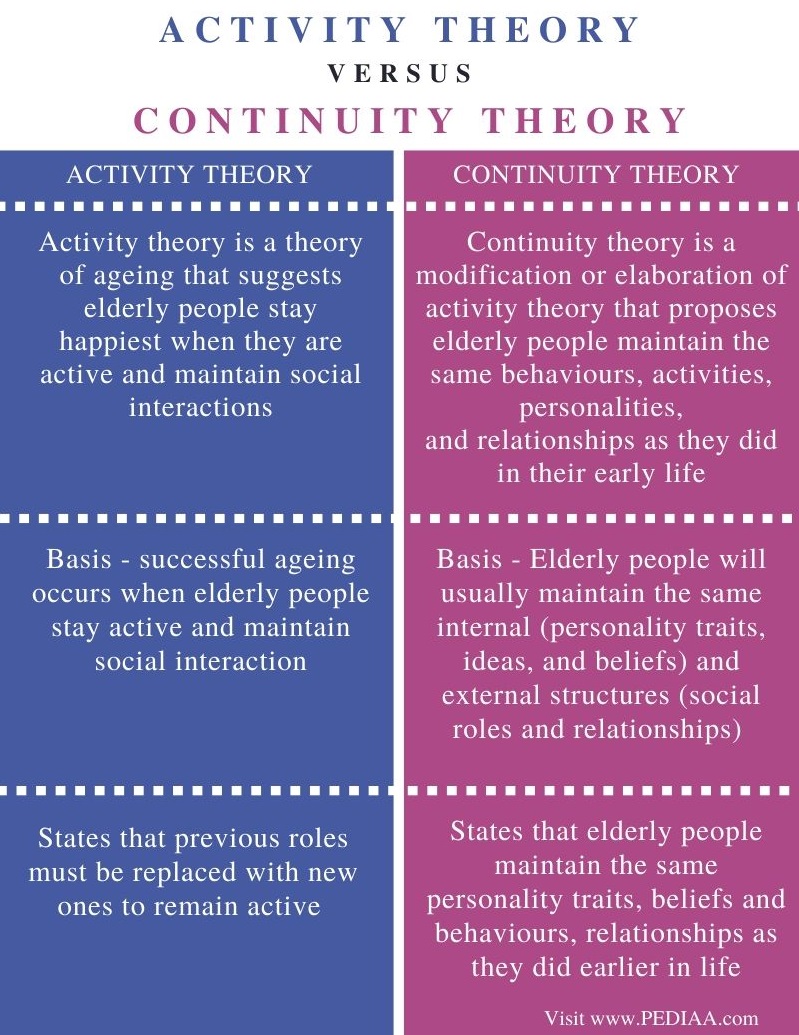
We can see this theory in practical ways almost every day.

To put it another way: the more you’re able to do as you get older, then the better your body will be aging. This, in turn, allows this person to age in a successful way.
ACTIVITY THEORY OF AGING EXAMPLE FULL
When an individual is able to engage in a full day of activities, then they are able to perceive a personal level of productivity. How Does the Activity Theory of Aging Work? It assumes that there is a positive relationship between one’s overall satisfaction and their ability to participate in activities. Ultimately, the continuity theory urges the older generation to maintain everything that gave them joy when they were younger.How do adults stay happy as they get older? According to the activity theory of aging, older adults who remain active and are able to maintain their social interactions find the highest degrees of happiness in their lives.įirst developed by Robert Havighurst in 1961, the theory proposes that older adults maintain an optimal aging rate when they are able to continue pursuing activities and relationships which interest them. She is happy because she continues to do what she began in her earlier years. At 85 years old, Anna still performs and teaches dance (‘Reflections on aging’, n.d.). They should uphold their personality and maintain the relationships they formed. This theory holds that the elderly should make the choice to maintain consistency in internal and external structures throughout their lives (‘Theoretical perspectives on aging’, n.d). The experiences of Anna Halprin can best be described by the continuity theory of aging. It would not provide positive solutions to loneliness among the older generation. This theory is harmful because it is defeatist, theorizing that isolation is a natural and unavoidable part of life.

Their social relationships will crumble as they disengage from society. This theory suggests that growing old is part of being human, and as human beings grow older, it is natural that they will withdraw from society (‘Theoretical perspectives on aging’, n.d). The disengagement theory will be harmful if applied to the aging population. Therefore, the federal government should utilize the age stratification theory to provide a solution for isolation among the elderly. According to studies, social support activities such as counseling and therapy help to alleviate loneliness in older people (Fakoya et al., 2020). This will be beneficial for the older generation since loneliness negatively impacts mental health. Using this perspective, the government can expand Medicare benefits to include services such as counseling. This theory asserts age is used as a factor to determine the number of social resources accessible to a person (‘Theoretical perspectives on aging’, n.d).

A different approach that can be recommended utilizes the age stratification theoretical approach. Here, they interact with each other and form a separate community from the one outside. This is witnessed in societies, such as the American one, where older people are placed in homes for the aged. This theory suggests that since they are isolated by the larger community, the elderly form their own communities. The subculture of aging theory has been applied to the aging population.

Japan’s approach is better because it ensures the elderly are kept occupied and are not isolated. In America, old people are isolated because they are placed in nursing homes, where they do not get much interaction with the general public. This is an example of the theoretical activity perspective where happiness in old age is derived from participating in societal activities. For instance, older people teach origami classes to the young (‘Aging in Japan’, n.d.). The younger and middle-aged generations actively involve older people in day-to-day activities. Keeping older American citizens engaged will help to prevent them from feeling lonely and isolated.Īmerica can borrow from Japan’s theoretical approach, where members of society cater to elderly people. It posits that social engagement is the key to being happy in old age. This theory suggests that individuals enjoy old age by finding new activities to do to substitute the statuses they used to occupy in society (‘Theoretical perspectives on aging’, n.d.). Social isolation among the elderly in the US can be reduced through the application of the activity theory.


 0 kommentar(er)
0 kommentar(er)
